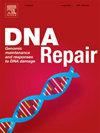Shu复合物是一种atp酶,在DNA损伤反应中的同源重组过程中调节Rad51细丝。
IF 2.7
3区 生物学
Q2 GENETICS & HEREDITY
引用次数: 0
摘要
Rad51细丝是由Rad51包被的单链DNA,是同源重组(homologous recombination, HR)所必需的。酵母Shu复合体(Shu)是同源重组的保守调节因子,通过其对Rad51细丝的调节来指导hr相关的DNA损伤反应。然而,Shu的生化特性尚不清楚,这阻碍了对Shu在HR和DNA损伤反应中的作用的分子认识。在这项工作中,我们对Shu进行了生化表征,并分析了其在单链DNA和Rad51细丝上的分子作用。首先,我们发现Shu优先将叉形DNA与20nt ssDNA组分结合。然后,我们通过位点特异性诱变鉴定并验证了Shu是一种ATP酶,并以依赖dna的方式水解ATP。此外,我们发现Shu与ssDNA和Rad51丝相互作用,并改变了ssDNA和具有5‘-3’极性的丝的性质。这种改变依赖于Shu的ATP水解,表明Shu的ATP酶活性在调节其功能中起重要作用。Shu倾向于作用于Rad51细丝的5'端,这与Shu促进复制叉后链病变旁路的观察结果一致。我们对真核生物中Rad51丝的原型调节剂Shu的研究,提供了Rad51介导的无差错DNA损伤旁路的一般分子机制。本文章由计算机程序翻译,如有差异,请以英文原文为准。
The Shu complex is an ATPase that regulates Rad51 filaments during homologous recombination in the DNA damage response
Rad51 filaments are Rad51-coated single-stranded DNA and essential in homologous recombination (HR). The yeast Shu complex (Shu) is a conserved regulator of homologous recombination, working through its modulation on Rad51 filaments to direct HR-associated DNA damage response. However, the biochemical properties of Shu remain unclear, which hinders molecular insights into Shu’s role in HR and the DNA damage response. In this work, we biochemically characterized Shu and analyzed its molecular actions on single-stranded DNA and Rad51 filaments. First, we revealed that Shu preferentially binds fork-shaped DNA with 20nt ssDNA components. Then, we identified and validated, through site-specific mutagenesis, that Shu is an ATPase and hydrolyzes ATP in a DNA-dependent manner. Furthermore, we showed that Shu interacts with ssDNA and Rad51 filaments and alters the properties of ssDNA and the filaments with a 5′-3′ polarity. The alterations depend on the ATP hydrolysis of Shu, suggesting that the ATPase activity of Shu is important in regulating its functions. The preference of Shu for acting on the 5′ end of Rad51 filaments aligns with the observation that Shu promotes lesion bypass at the lagging strand of a replication fork. Our work on Shu, a prototype modulator of Rad51 filaments in eukaryotes, provides a general molecular mechanism for Rad51-mediated error-free DNA lesion bypass.
求助全文
通过发布文献求助,成功后即可免费获取论文全文。
去求助
来源期刊

DNA Repair
生物-毒理学
CiteScore
7.60
自引率
5.30%
发文量
91
审稿时长
59 days
期刊介绍:
DNA Repair provides a forum for the comprehensive coverage of DNA repair and cellular responses to DNA damage. The journal publishes original observations on genetic, cellular, biochemical, structural and molecular aspects of DNA repair, mutagenesis, cell cycle regulation, apoptosis and other biological responses in cells exposed to genomic insult, as well as their relationship to human disease.
DNA Repair publishes full-length research articles, brief reports on research, and reviews. The journal welcomes articles describing databases, methods and new technologies supporting research on DNA repair and responses to DNA damage. Letters to the Editor, hot topics and classics in DNA repair, historical reflections, book reviews and meeting reports also will be considered for publication.
 求助内容:
求助内容: 应助结果提醒方式:
应助结果提醒方式:


